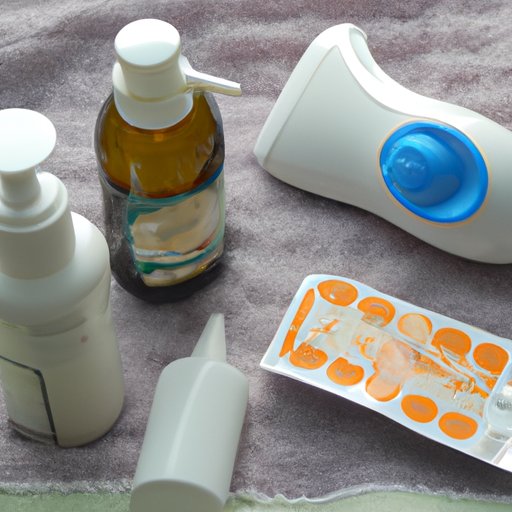Introduction
Bed sores, also known as pressure ulcers, decubitus ulcers, and pressure injuries, are areas of damaged skin caused by prolonged pressure on an area of the body. They are most common in people who are bedridden, wheelchair-bound, or otherwise immobile due to a disability or illness. Bed sores can range from mild to severe and can be difficult to treat if not addressed quickly.
Utilize Pressure-Relieving Devices
One of the best ways to prevent and treat bed sores is to utilize pressure-relieving devices. These devices are designed to reduce the amount of pressure on an area of the body, helping to prevent bed sores from forming in the first place. Common types of pressure-relieving devices include foam cushions, air mattresses, water beds, sheepskin, and gel pads.
The benefits of using pressure-relieving devices include improved circulation, reduced friction, and minimized risk of skin breakdown. Additionally, pressure-relieving devices can help improve comfort and provide relief from pain associated with existing bed sores. It’s important to note that these devices must be used properly in order to be effective.
Change Positions Regularly
Another important step in treating bed sores is to change positions regularly. This helps to distribute the weight of the body more evenly, reducing the amount of pressure on an area of the body and preventing bed sores from forming. Generally speaking, it’s recommended to change positions every two hours if possible. However, this may vary depending on the person’s individual needs.
In addition to preventing bed sores, regularly changing positions can also help to reduce pain and discomfort associated with existing bed sores. It can also help reduce the risk of infection, since bacteria can accumulate in one area if left unchecked.

Keep the Skin Clean and Dry
Keeping the skin clean and dry is another important step in treating bed sores. Washing the affected area with a gentle cleanser, such as mild soap and warm water, can help to remove dirt, sweat, and other debris that can contribute to skin breakdown. It’s important to be gentle when washing the area, as vigorous scrubbing can cause further damage.
Once the area has been washed, it’s important to thoroughly dry the area with a soft cloth. If possible, it’s best to use a hair dryer set on the lowest setting to completely dry the area. This will help to reduce the risk of infection and keep the skin from becoming irritated.
Use Antibiotic Creams or Ointments
In some cases, it may be beneficial to use antibiotic creams or ointments to help treat bed sores. These products can help reduce inflammation, promote healing, and reduce the risk of infection. Common types of antibiotic creams and ointments include bacitracin, mupirocin, and silver sulfadiazine.
When applying antibiotic creams or ointments, it’s important to follow the directions provided on the product’s label. Additionally, it’s important to avoid using too much of the product, as this can cause skin irritation and increase the risk of infection.

Consider Medications for Pain Relief
In some cases, medications may be necessary to provide relief from pain associated with bed sores. Common types of medications used to treat bed sores include nonsteroidal anti-inflammatory drugs (NSAIDs), opioids, and topical creams. It’s important to consult with a doctor before taking any medication, as some medications may have serious side effects.
In addition to providing relief from pain, medications can also help to reduce inflammation and promote healing. However, it’s important to note that medications should not be used as a substitute for proper care, such as keeping the skin clean and dry, changing positions regularly, and utilizing pressure-relieving devices.
Receive Nutritional Support
Nutrition is an important part of treating bed sores. Eating a well-balanced diet that includes plenty of fruits, vegetables, whole grains, and lean proteins can help to improve overall health and provide the nutrients needed for healing. Additionally, certain supplements, such as vitamin C and zinc, can help to promote healing.
It’s also important to drink plenty of fluids to prevent dehydration. Dehydration can slow the healing process and make it more difficult to treat bed sores. It’s recommended to drink at least 8 glasses of water per day.
Seek Medical Attention Immediately
In some cases, bed sores may become infected or worsen despite treatment. In these cases, it’s important to seek medical attention immediately. Signs of infection include redness, swelling, discharge, fever, and increased pain. If any of these signs are present, it’s important to contact a doctor right away.
Additionally, it’s important to seek medical attention if the bed sore does not appear to be improving or if new bed sores appear despite treatment. A doctor may recommend additional treatments, such as antibiotics or surgery, to help treat the bed sores.
Conclusion
Bed sores can be painful and difficult to treat. However, with the right treatment, they can be managed effectively. Utilizing pressure-relieving devices, changing positions regularly, keeping the skin clean and dry, using antibiotic creams or ointments, considering medications for pain relief, receiving nutritional support, and seeking medical attention immediately can all help to treat and prevent bed sores.


